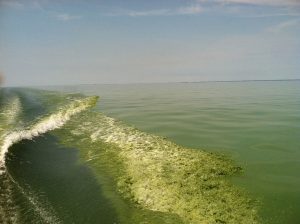
At the 8th Binational Meeting of the Lake Erie Millennium Network, 125 scientists gathered at the University of Windsor in Ontario to hear experts weigh-in on the health of the southernmost, warmest and shallowest of the Great Lakes.
They presented research on everything from climate change, water quality, phosphorous, agricultural run-off, cynobacteria (blue-green algae), hypoxia (deficiency in oxygen), cladophora (green algae) to ice, invasive species, sediment concentrations, and much, much more.
Lake Erie is the smallest of the Great Lakes by volume, and yet it has the highest population living along it’s shorelines, which makes it more vulnerable to pollution and many other problems than the rest of the Great Lakes.
The Canadian province of Ontario as well as the states of Ohio, Pennsylvania, New York and Michigan share its shoreline. Nearly 12 million people get their drinking water from Lake Erie.
Its primary inlet is the Detroit River.
Lake Erie is important not just for its drinking water, beaches, swimming and boating, but for its fish. The number of anglers on Lake Erie is greater than any other of the Great Lakes.
The lake, unfortunately, is famous for getting so polluted in the late 1960’s, one of its tributaries caught fire. The incident helped lead to the formation of the EPA, the Clean Water Act and other regulatory agencies and regulations.
Over the past fifty years, there have been incredible improvements to the quality of Lake Erie, but the scientists at the conference admitted they were concerned about some of the old issues that led to Lake Erie’s pollution returning once again without constant research, monitoring and regulations.
The Threat of Algal Blooms and Invasive Species

Algal bloom in Lake Erie, courtesy of NOAA
One of the biggest threats the scientists are worried about, and what received the most attention: algal blooms. They are caused by an influx of phosphorous run-off from farms that use fertilizers and manure. The eastern portion of Lake Erie is often slimy with the bright green mess. But it isn’t just ugly, say these experts. It can kill plant life and fish and even lead to liver damage.
Another big concern: invasive species like Asian carp, zebra and quagga mussels and round gobies, which are affecting fishing and Lake Erie’s shoreline.
Recent stories from Great Lakes Now about Lake Erie:
A Massive and Significant Loss of Ice

Dr. Robert Michael McKay, courtesy of Mary Ellen Geist
What was alarming to many of the scientists: the rate of the loss of ice on all the Great Lakes. Bowling Green State University’s Dr. Robert Michael McKay, a Ryan professor of biology revealed at the conference that there has been “ a 75 percent decline in ice on the Great Lakes over the past fifty years.” Dr. McKay tells Great Lakes Now, “It is significant and it parallels the declines in ice cover we’re seeing in the Arctic at present as well.“
Dr. McKay says what many people don’t realize is that ice cover provides physical protection for fish and fish eggs, and protects shorelines from erosion, too.
Dr. McKay says, “We are seeing an increase in the frequency of very low ice on Lake Erie and the Great lakes in general, and lack of ice cover results in a major shift in the food web.”
So why is it happening? Dr. McKay says, “It’s consistent with what humans have been doing to their environment since the beginning of the industrial age: excess greenhouse gases in the atmosphere. “
H.R. 861, The Bill that Would Terminate the EPA
But perhaps most startling, said keynote speaker Dr. Jeff Reutter, special advisor for the Ohio Sea Grant program, is the threat to the future of Lake Erie from the potential dissolution of the agency that watches over the U.S. environment and creates regulations to protect it.
The bill, called H.R. 861, introduced to the 115th Congress by Florida Republican Congressman Matt Gaetz on February 3, 2017, calls for the termination of the Environmental Protection Agency.
Dr. Reutter said, “If we lose the EPA, we lose Lake Erie”.
Dr. Reutter directed the Ohio Sea Grant program starting in 1987. He retired in 2015. He’s been working on Lake Erie since 1971. He tells Great Lakes Now he’s worried about the future of the lake.
He says, “Right now, excessive nutrient loading is causing three problems in Lake Erie:
harmful algal blooms in the Western Basin; a dead zone – an area of zero oxygen – at the bottom of the central basin between Pelee point and Long Point; and then in the Eastern basin, excessive growths of cladophora.”
He blames agricultural run-off for the problems, but he says phosphorous can come from other sources, too. He says “the algae don’t care where the phosphorous comes from”. He says, in 2013, 2000 people living near the Lake Erie watershed were forced to stop drinking their water due to toxic levels of phosphorous and in 2014, the city of Toledo – about 400 thousand people – were also forced to stop drinking their water for the same reason.
Dr. Reutter says without regulations from agencies like the EPA and constant monitoring and vigilance from scientists, Lake Erie will suffer and could return to pollution levels of decades ago.
The dozens of presentations at the meeting over a three-day period, called “Status of Lake Erie: Understanding the Nearshore and its Connections” were the result of three to four years of research from Environment and Climate Canada, The U.S. EPA’s Research Lab in Grosse Ille, Michigan, and the Ohio Sea Grant/F.T. Stone Lab at Ohio State.
Featured Image: Satellite image of Lake Erie in September 2011, overlaid on a map of the lake and its tributaries.
10 Comments
-
I make this comment to the lake scientists and the EPA.
Agriculture areas must use part of the land for moats sufficient for runoff. The water in these moats can be used for irrigation and they can be dredged and that already enriched material be spread back on the fields. The need for purchasing less fertilizer would compensate to whatever amount. -
PATHETIC
-
We need to practice better farming , most of the smaller farmers are doing this. It is the big ad farms that do the most damage, and have not changed their practices, because they have power over the politicians
-
Support and Fight for #LakeErieBillofRights!
-
Your article has inspired me to read into this proposed bill further. However, if we are solely dependent on the EPA or any single agency for the health of the great lakes then we are sadly in trouble already. There is more than 50+ agencies, community watch dogs, researchers and citizens that every day glimpse into the environment and can help us be better stewards of our environment. I think the key is supporting and connecting all these bits of information and collectively acting on the insights we learn from them. The challenge is data is to disparate and silo’d to even begin to understand if we are making progress or in decline. I recently learned of an organization working to figure this all out, blueaccounting.org. They are looking to connect these pieces of information and turn them into actionable insights. We should support more programs like theirs if we truly want to make a difference, not just react but be proactive, predictive and preventative. The EPA is a part of that but they are one spoke among many in a wheel that has information and monitors the great lakes.
-
So, government is the savior?
Didn’t Government write legislation and create administrations that permitted and incentivized farmers to use phosphorus? -
Yawn, y’all know that it doesn’t take a federal government agency to protect, or enforce local government laws? The EPA is a waste of taxpayer dollars, along with countless of other federal agencies…that $$, collected at state levels, could be used addressing the focus where it’s needed. The sooner “we the people,” figure out how much waste is going on, on the hill. The sooner we can get busy cleaning up this bureaucratic bs mess.
-
Please note that any bill introduced in either US House or Senate in 2017 but not signed into law, died at the close of that Congressional session at the end of 2018. If it’s been reintroduced in the current 2-year session of Congress it will most likely have a different bill number.
-
Until more people demonstrate that they will act responsibly, we do need regulations, but only if they benefit and encourage healthy farming practices and are enforced equitably. If the farmers stopped using chemical fertilizers and paid more attention to building soil biota and tilth, and replanted out trees, there would be no or less runoff into waterways, causing poisoning, algae bloom, anaerobic zones, etc.
-
Hey, bud who’s yawning, how well have states acted jointly? That’s what you appear to be suggesting, right? When it comes to potential collaboration among the states that border Chesapeake Bay, such collaboration is sorely wanting–they’ve been “working” on saving the bay for decades. This points up the effectiveness of national legislation that involves multiple stakeholders. Also, please explain how EPA –and any other agencies you’d care to name–have wasted taxpayer dollars? Also, do you buy into any level of government?




